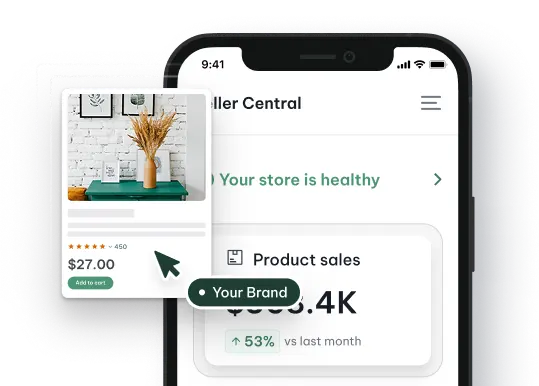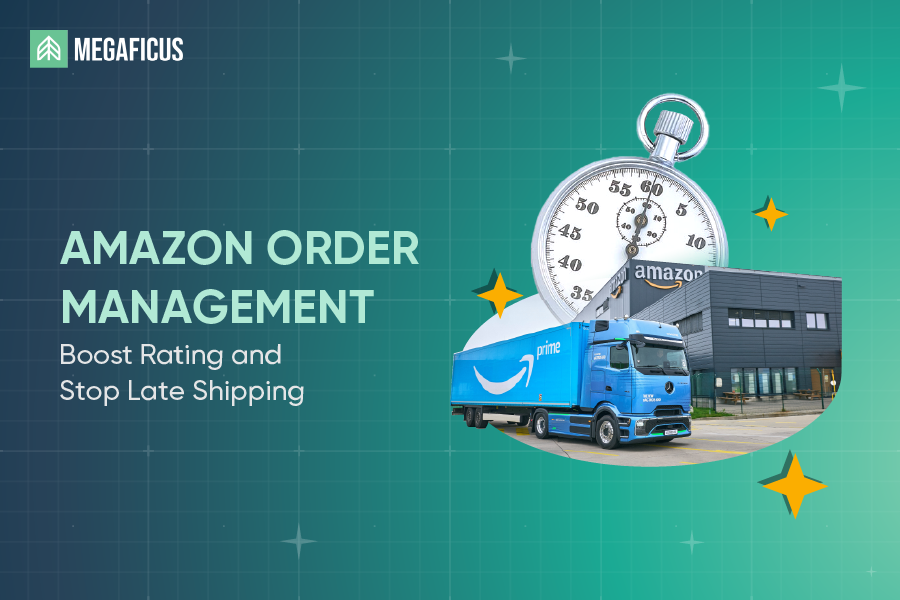Can’t figure out why your products aren’t converting despite good traffic? Reviews are the deciding factor between browsers and buyers on Amazon. Learn how to master Amazon Review Management to build credibility, increase rankings, and turn customer feedback into consistent sales in this guide by Megaficus.
Quick Summary
- Amazon Review Management is the process of monitoring, requesting, and responding to customer feedback to maintain reputation, boost visibility, and drive sales on Amazon.
- Why it matters: Reviews directly impact search rankings, conversion rates, trust, and Buy Box eligibility, with 4.5+ star products converting 120% better.
- How to get reviews: Use Amazon’s Vine Program, Request a Review button, automation tools, or leverage social media for organic engagement to generate authentic feedback while staying compliant with platform policies.
- Best practices: Time requests 5-7 days post-delivery, respond professionally within 24-48 hours, never offer incentives or request only positive reviews to avoid account suspension.
What Is Amazon Review Management?
Amazon Review Management is the process of monitoring, analyzing, and responding to customer reviews on product listings. This practice helps sellers maintain their reputation, boost visibility, and drive sales. Additionally, it involves encouraging authentic feedback while addressing negative comments to optimize overall product performance.
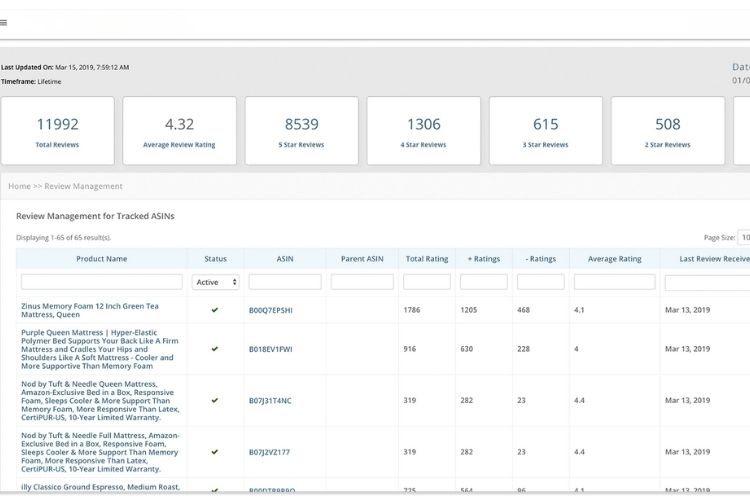
Why Is It Important to Manage Your Amazon Reviews?
Customer reviews significantly influence purchasing decisions and directly affect your product’s success on Amazon. Without proper review management, sellers risk losing visibility, sales, and competitive advantages in the marketplace:
- Search rankings: Amazon’s A9 algorithm prioritizes products with higher review scores and volume, placing them at the top of search results.
- Conversion rates: Positive reviews increase buyer confidence, leading to faster purchase decisions and higher add-to-cart rates.
- Trust and credibility: Shoppers rely on authentic feedback to evaluate product quality before making buying decisions.
- Buy Box eligibility: Strong review performance improves your chances of winning the Buy Box over competitors.

How Does Amazon’s Review System Work?
Amazon’s review system operates through a sophisticated algorithm that evaluates and ranks customer feedback based on multiple factors. Therefore, understanding how this system functions helps sellers optimize their review management strategies and improve their product visibility on the platform.
Amazon prioritizes reviews based on the following key factors:
- Verified Purchase status: Reviews from customers who bought the product directly on Amazon carry more weight in the overall star rating and appear more prominently.
- Review age and recency: Newer reviews are given higher priority as they reflect the current product quality and customer experience.
- Helpful votes: Customers can mark reviews as “helpful,” and those with more votes rank higher on the product page, increasing their visibility.
- Reviewer history: Amazon values reviews from customers with a strong history of leaving helpful, detailed feedback over accounts with limited activity.
- Machine learning algorithms: Amazon uses AI models that continuously learn and improve to detect authentic reviews and filter out suspicious or manipulated feedback.
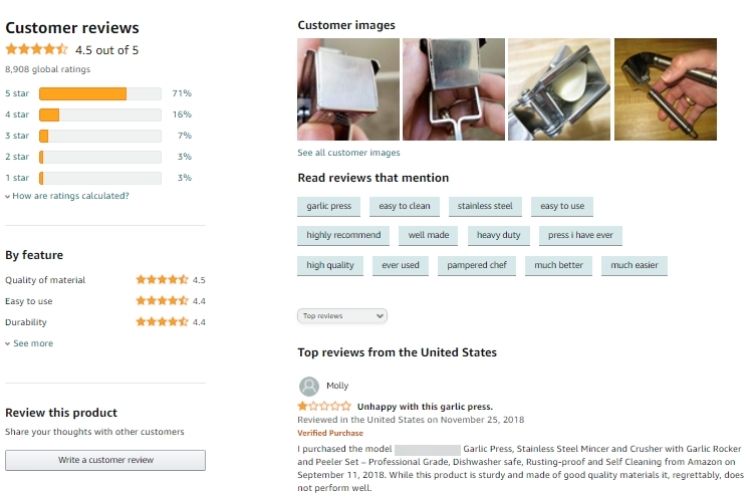
How To Get More Amazon Reviews Legally
Building a strong review profile requires implementing proven strategies that align with Amazon’s guidelines. Below are three effective methods currently working for sellers to generate more authentic customer feedback.
Amazon’s Vine Program
The Vine Program allows brand-registered sellers to enroll their products for testing by trusted reviewers called Vine Voices. These experienced reviewers receive your product at no cost and share honest, detailed feedback based on their experience.
To participate, you need to enroll eligible products through Amazon Brand Registry and pay the program fee, which varies by product category. While this program delivers high-quality reviews quickly for new product launches, keep in mind that reviews may be positive or negative, and participant slots are limited.
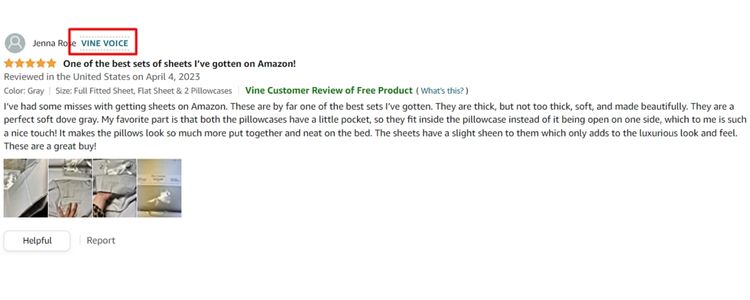
Request A Review Button in Seller Central
Amazon provides a “Request a Review” button in Seller Central that sends standardized review requests to customers after purchase. To use this feature, navigate to your Orders page, locate the specific order, and click the button within 5-30 days after delivery.
This method works well for sellers processing up to 10 orders daily. However, if you handle 100+ orders per day, manual clicking becomes inefficient, and you should consider using automation software to trigger requests automatically while maintaining compliance.

Automate Review Requests With Software
Review automation tools like FeedbackFive, eDesk, or Helium 10 to streamline the review request process by automatically sending messages to customers after delivery. These platforms save significant time for high-volume sellers while maintaining full compliance with Amazon’s policies.
So, how to set up automation:
- Connect your account: Link your Amazon Seller Central account to the automation software.
- Create email templates: Write review request messages that follow Amazon’s guidelines (neutral tone, no incentives).
- Set trigger conditions: Configure the system to send requests 5-7 days after delivery based on order status.
- Monitor performance: Track request rates, response rates, and review conversion metrics through the analytics dashboard to refine your strategy.
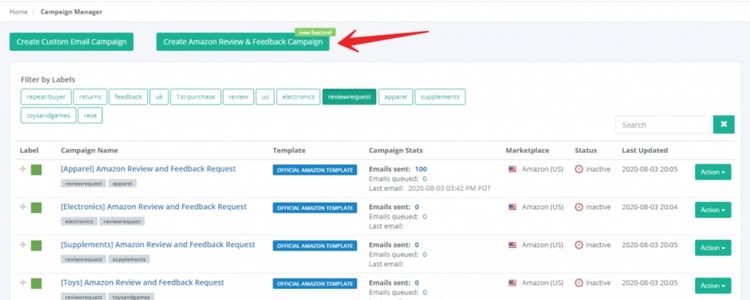
Leverage Social Media For Organic Engagement
Social media platforms like Instagram, Facebook, and YouTube help build brand awareness and drive traffic to your Amazon listings. Sellers can create engaging content, encourage customers to share experiences through user-generated posts, and build authentic communities around their brand.
However, sellers must never directly request reviews or offer incentives through social media, as Amazon detects suspicious patterns and may suspend accounts. Instead, focus on genuine engagement that naturally motivates satisfied customers to leave voluntary reviews on Amazon.

When To Consider Amazon Review Management Services?
Consider hiring review management services when you experience:
- High order volume: Processing 100+ daily orders makes manual review requests impractical and time-consuming, requiring automated systems and dedicated oversight.
- Stagnant or declining ratings: Your overall star rating has dropped below 4.0 or remains stuck despite improvement efforts, impacting conversions and visibility.
- Frequent negative reviews: You’re receiving multiple low-star reviews weekly and lack the resources or expertise to respond professionally and resolve issues promptly.
- Limited time and resources: Your team is overwhelmed managing other aspects of the business, leaving little capacity for proactive review, monitoring, and customer engagement.
- New product launches: Launching products requires building initial review credibility quickly through compliant programs like Amazon Vine and strategic outreach.
- Fake or malicious reviews: Competitors are posting suspicious reviews, and you need expert help identifying violations, documenting evidence, and filing appeals with Amazon.
Best Practices For Managing Amazon Reviews
Effective review management requires a strategic approach that combines timing, personalization, and compliance. Below are proven practices to help you generate authentic customer feedback while maintaining Amazon’s trust and guidelines.
Responding To Reviews Professionally
When customers leave positive reviews, sellers should respond with brief thank-you messages that acknowledge feedback and reinforce brand loyalty, such as “Thank you for choosing our product! We’re thrilled you’re satisfied.”
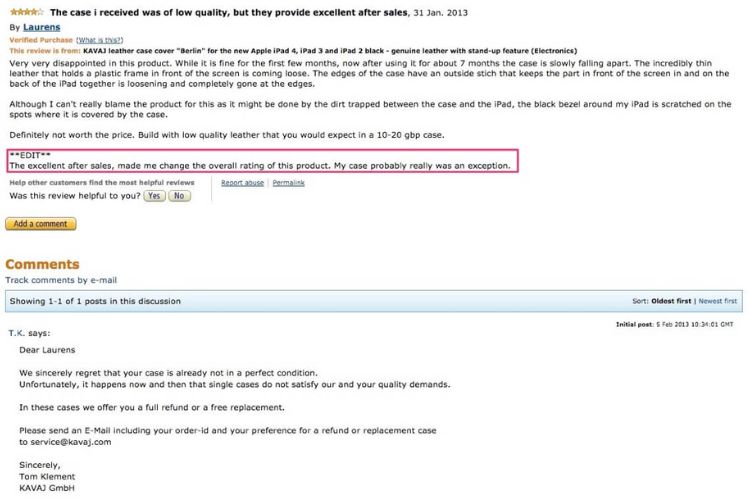
Sellers should respond within 24-48 hours to demonstrate they take concerns seriously, maintaining a professional tone even when reviews seem unfair. Additionally, sellers should offer solutions such as replacements or refunds to resolve issues privately and encourage customers to update their reviews after resolution.
Setting Up Review Automation Workflows
Sellers should connect their Amazon Seller Central account to tools like Jungle Scout or Helium 10, then configure triggers to send requests 5-7 days post-delivery. Additionally, sellers should set exclusion filters to avoid sending requests for refunded or problematic orders.
Sellers must regularly monitor metrics such as open rates and conversion rates to optimize their automation strategy. Most importantly, sellers must ensure all automated messages comply with Amazon’s policies by avoiding incentives and staying within the 30-day messaging window.
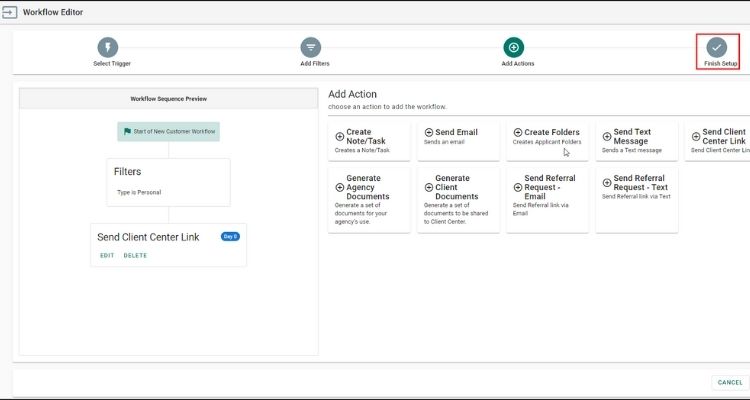
Maintaining Compliance with Amazon TOS
Amazon enforces strict policies to ensure review authenticity, so sellers must understand permitted versus prohibited actions. Sellers can request honest reviews through Amazon’s official tools and approved messaging, but they cannot offer incentives or request only positive reviews.
Non-compliance results in severe penalties, including review removal, listing suppression, or account suspension. Therefore, sellers should regularly review Amazon’s updated policies and verify that third-party tools comply with current API and messaging restrictions.
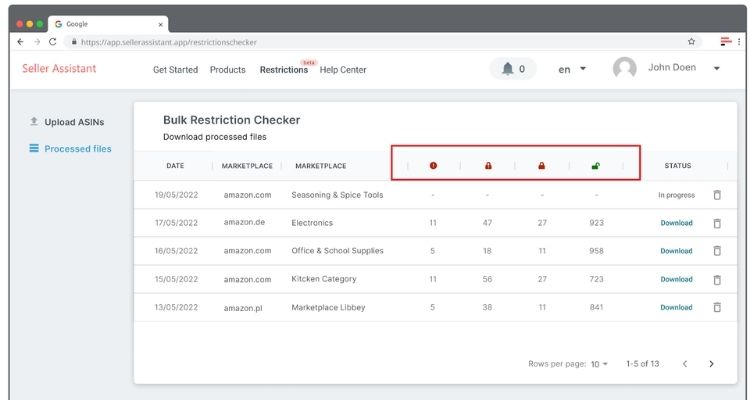
Reporting Policy-Violating Reviews
Sellers can protect their ratings by identifying and reporting reviews that violate Amazon’s guidelines, such as those containing offensive language, promotional content, or false claims.
To report a review, click the “Report” button below the review and provide clear evidence explaining the violation. Additionally, sellers should regularly audit their review profiles to catch policy violations early and maintain a clean, trustworthy feedback section.
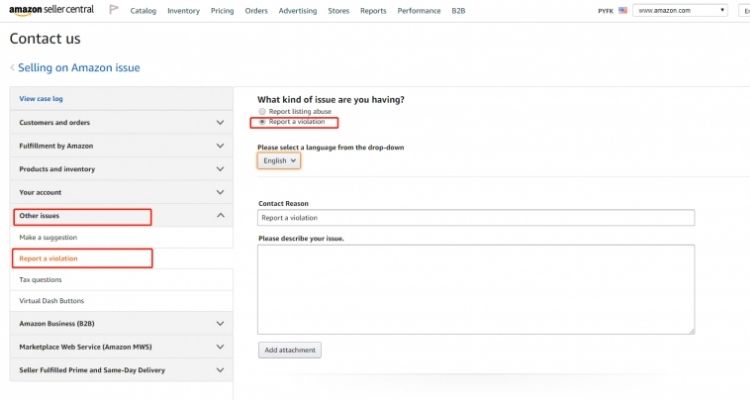
Optimizing Product Listings For Better Reviews
Sellers should upload at least 7 high-resolution images showing the product in use, packaging contents, and size comparisons with common objects. Product descriptions must clearly state what the product does NOT include, material quality levels (e.g., “plastic, not metal”), and realistic use cases to avoid buyer disappointment.
For example, if you sell a phone, specify the exact phone models it fits, the material thickness, and whether screen protectors are included. Accurate listings reduce return rates by up to 40% and naturally generate more positive reviews from customers who receive exactly what they expected.
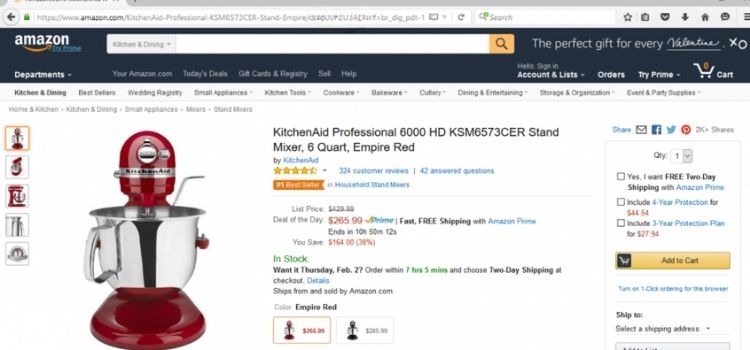
Utilize Product Inserts
Product inserts are physical cards placed inside packaging that remind customers to leave reviews when their experience is fresh. Sellers should include a brief thank-you message, a QR code linking directly to the review page, and customer service contact information to resolve issues before negative reviews occur.
This method works because it catches customers during unboxing excitement, eliminates friction through one-click QR access, and offers proactive support channels. However, sellers must never request positive reviews or offer incentives, as this violates Amazon’s policies and can result in account suspension.

Frequently Asked Questions about Amazon Review Management
Amazon review management is the process of monitoring, requesting, and responding to customer feedback to maintain reputation and stay compliant with Amazon’s policies.
Use Amazon’s “Request a Review” button or third-party tools like Jungle Scout and Helium 10 to automatically send requests 5-7 days after delivery.
Sellers cannot directly remove reviews, but can report policy violations to Amazon or contact customers privately to resolve issues and request updates.
Yes, requesting honest feedback through Amazon’s official tools is legal, but offering incentives or requesting only positive reviews violates the Terms of Service.
Get Professional Help from Megaficus
Amazon Review Management is not about begging for feedback; it’s about building a systematic strategy that generates authentic reviews while staying compliant. By mastering review requests, responding professionally, and using automation tools, sellers can transform customer feedback into a powerful sales driver.
Proper review management helps you avoid account suspensions, recover from negative feedback faster, and build long-term credibility that converts browsers into buyers. A strategic approach gives you a clear competitive advantage in Amazon’s marketplace.
If you’re looking for expert support to optimize your Amazon review strategy and accelerate growth, the team at Megaficus is ready to help.


